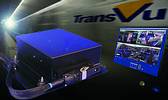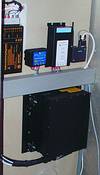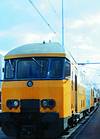

There seems to be little sign that the threat of terrorist attack across our global transport infrastructure, including its rail networks, is going to disappear any time soon. In fact, recent events have only served to underline the dangers rail operators and their passengers face. As a result, we are likely to witness an ever broader spectrum of measures being applied, including CCTV, to heighten vigilance in railway stations, on commuter trains and along thousands of kilometres of railway track.
Here, John Goy, senior product manager at Dedicated Micros, looks at the solutions being adopted by our European counterparts, specifically the performance characteristics of mobile CCTV solutions, highlighting what rail operators should demand from the latest systems.
One approach which has generated considerable interest in a number of countries - including UK, Spain, the Netherlands and Germany - is the application of multicamera digital recorders. When fitted to trains these compact, self-contained systems are capable of continuously monitoring the inside of carriages. There is even the potential to conduct remote surveillance from trains on key routes, so complementing the existing permanently positioned CCTV infrastructure.

From air to ground
The origins of this technology can be traced back to the aviation sector, where, since the mid-1990s, such systems have proven their worth on commercial passenger jets. Here, digital recorders, linked to internal and external cameras, have been able to assist aircrew and attendants by providing critical monitoring of the cockpit door, passenger cabin, cargo hold and the undercarriage of aircraft.
Now, spurred on by more sophisticated software, ever-increasing computing power and the advent of low cost, high capacity disk drives, the economics and refinement of these mobile multicamera digital recorders is such that they are proving an attractive proposition for installation on the ground.

Practical benefits
As well as the obvious potential of this technology to address the vulnerability of extensive railway infrastructure in the uncertain global climate, by helping train operators to spot unusual activity, it can also be applied to tackle the day-to-day headaches of vandalism and assaults on passengers and staff.
Applied as an overt measure, with the cameras in public view, experience suggests that this provides a significant deterrent to criminal damage, delivering much needed reassurance to the travelling public. This positive benefit was underlined in a recent trial in the Netherlands which found that 60% of commuter train passengers felt safer with digital recorders and cameras installed, train staff also believed that their working environment had improved and damage due to vandalism plummeted by 45%. Also, during the test period video recordings were reviewed on several occasions, assisting the police and the train operator to solve a number of incidents. Significantly, the success of the trial has led to its expansion to every double train on the Dutch route.
Recording on the move
So what should a typical multicamera digital recording system be able to offer transport operators? Units ought to be capable of multiplexing and recording from up to eight video cameras per carriage. Further, multichannel audio recording can be used to store relevant voice information and the associated images from multiple points on a train, especially useful in incidents of staff or passenger abuse. Storage is usually via one or two internal hard disk drives, although some operators may prefer a single removable drive which can be taken from a unit in the event of an incident.
While to a user it may appear that this type of unit operates in a similar way to a multiplexer and VCR during standard recording, there are significant benefits beyond these more traditional approaches, including, of course, the fact that everything is stored digitally. The latest units can for instance apply different record rates to specific cameras. As a result of this 'variable rate' recording more important cameras can be prioritised in the recording sequence. Alarm inputs or system events can be used to trigger changes in the recording speed, making it possible to record incidents at a much faster rate than normal.
When making a selection, it is advisable to look out for units with an advanced go-to-time feature, supporting playback from a specified time and date to tie-in with particular incidents. It is also beneficial if the system software supplied facilitates visual searches of camera images at up to x1000 normal speed and even closer inspection at one quarter speed (slow motion) to allow for the rapid location and detailed study of incidents.
Power management
Auto power management is certainly becoming a more common feature in multicamera digital recorders. Typically, this stops a unit recording and closes down operation 15 minutes after a vehicle is taken out of service - a time period which can also be defined by the user. The unit will also conduct a controlled and timed power down sequence when the vehicle's voltage has fallen below a set level. Once the minimum operating voltage is reached this is immediate. With a pass through relay controlled power feature, during normal operation, voltage is supplied (the same as the input) to peripheral devices such as cameras. This is removed when the digital recorder itself is powered down.
The answer is evidential
All individual images stored by a digital recorder - which can be archived to PC or mass storage devices - should carry vital header information including date and time and details of any alarms. Ideally some of this information should be able to be displayed with the image on playback. With the potential for images to end up in court as evidence, systems need to be designed to deliver a verified audit trail. The best systems will support watermarking where a unique fingerprint is assigned to a range of images. As a result, when evidence is submitted to the police - for example on CD - the watermark data can be issued as a watermark certificate. To verify the authenticity of the CD at a later stage a second certificate can be created from the images on the CD. If the two certificates match then the CD has not been tampered with. In some cases evidence provided by such units may even be able to assist train operators by providing vital protection against fraudulent attack/injury claims.
Rugged construction
Undeniably, the passenger transport environment places rigorous demands on any electronic system so the solution selected for this type of application has to be extremely durable. Ideally the compact sealed recorder unit needs to be suspended via aerospace grade mountings to eliminate heavy vibration.
Information download
With wireless Internet access starting to become more commonplace on trains, consideration should be given to systems which, when combined with a broadband spectrum transceiver, have the capability to supply realtime information on a train's operational environment back to a control station. Where this facility is not available, data, including train speed, can be logged for later download.
In some cases, to enhance protection for staff and passengers, digital recorders are linked to a panic button. In the event of an emergency, the panic button is simply activated by authorised personnel, such as drivers or train managers, so initiating an immediate call to a control station for assistance.
An eye on the future
Looking ahead, there is little doubt that multicamera digital recorders are going to become an ever more common sight on public transportation world-wide, not only in the face of new global uncertainties but also to deter and respond to more usual concerns such as vandalism, including arson and graffiti, and attacks on staff.

© Technews Publishing (Pty) Ltd. | All Rights Reserved.